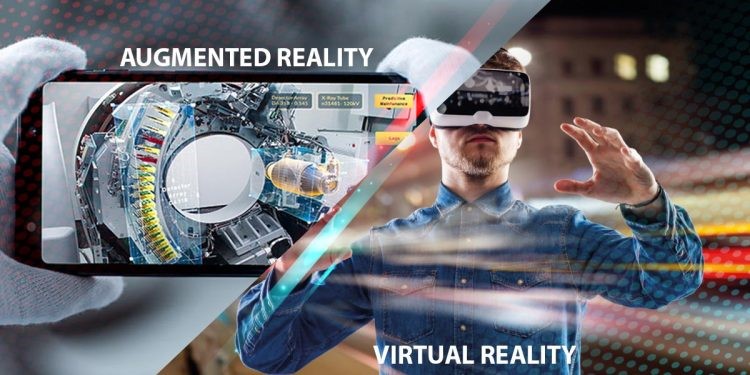
Augmented Reality (AR) and Virtual Reality (VR) stand at the forefront of technological innovation, promising to redefine the way we perceive and interact with the world around us. These immersive technologies offer a gateway to boundless realms where the physical and digital converge, creating experiences limited only by the depths of imagination.
In this introductory journey, we embark on a quest to unravel the transformative power of AR and VR. From understanding the fundamental principles that underpin these technologies to exploring their multifaceted applications across industries, we delve into a realm where innovation knows no bounds.Join us as we navigate through the landscapes of augmented reality and virtual reality, unlocking their potential to revolutionize education, healthcare, entertainment, retail, and beyond.
Augmented Reality (AR) and Virtual Reality (VR) are immersive technologies that offer distinct experiences yet share common principles in altering human perception and interaction with digital content.
Augmented Reality (AR): AR overlays digital information, such as images, videos, or 3D models, onto the user's real-world environment. This augmentation enhances the user's perception of reality by blending digital elements seamlessly with the physical world. AR technology typically relies on devices like smartphones, tablets, smart glasses, or heads-up displays to deliver the augmented experience.
Key components of AR technology include:
Key components of VR technology include:
Gaming and Entertainment:
One of the most prominent arena’s where AR and VR have made a significant impact is gaming and entertainment. With VR headsets, players can immerse themselves in breathtaking virtual worlds, whether it's exploring fantastical realms, battling intergalactic foes, or solving intricate puzzles. Games like Beat Saber and Half-Life: Alyx have redefined gaming experiences, offering unprecedented levels of immersion and interactivity.On the AR front, applications like Snapchat and Instagram have popularized AR filters, allowing users to augment their selfies with playful animations and effects. Moreover, AR gaming experiences such as Harry Potter: Wizards Unite and Minecraft Earth enable players to interact with virtual elements overlaid onto their real-world surroundings, turning the mundane into magical adventures.
Education and Training:
AR and VR are revolutionizing the way we learn and train by providing immersive and interactive experiences. In education, VR simulations can transport students to historical events, distant planets, or even inside the human body, offering a hands-on learning experience that textbooks cannot replicate. For instance, medical students can practice surgical procedures in a risk-free virtual environment before stepping into the operating room.In the realm of professional training, industries ranging from aviation to manufacturing are leveraging VR simulations to train employees in realistic scenarios without exposing them to real-world risks. Pilots can undergo cockpit familiarization, engineers can troubleshoot machinery, and firefighters can practice emergency responses, all within the safety of a virtual environment.
Healthcare and Therapy:
In healthcare, AR and VR technologies are driving innovation across various domains, from diagnostics and treatment to rehabilitation and therapy. Surgeons can use AR overlays during complex procedures to visualize patient anatomy in real-time, enhancing precision and minimizing risks. VR therapy is proving to be effective in treating phobias, PTSD, and anxiety disorders by exposing patients to controlled virtual environments where they can confront and overcome their fears.Moreover, VR simulations are being employed for pain management during medical procedures, distracting patients from discomfort by transporting them to serene landscapes or engaging experiences. Patients with physical disabilities can also benefit from VR-based rehabilitation exercises tailored to improve motor skills and cognitive functions, promoting faster recovery and enhanced mobility.
Architecture and Design:
In the realm of architecture and design, AR and VR are empowering professionals to visualize and prototype concepts with unprecedented realism and scale. Architects can use AR applications to superimpose digital models onto physical environments, enabling clients to explore proposed designs in real-time before construction begins. Interior designers can experiment with furniture placement and décor choices using AR tools, facilitating more informed decision-making and reducing design iterations.Similarly, VR technology allows architects and designers to create immersive walkthroughs of buildings and spaces, providing clients and stakeholders with a realistic preview of the final product. This level of immersion fosters better communication, collaboration, and feedback throughout the design process, ultimately leading to more successful and client-centric outcomes.
The future of Augmented Reality (AR) and Virtual Reality (VR) holds exciting prospects and emerging trends that promise to revolutionize various industries and human experiences:
Embracing the boundless potential of AR and VR invites us to reimagine possibilities, pushing the boundaries of creativity and exploration. From revolutionizing industries to enhancing education, healthcare, and entertainment, these technologies hold the promise of reshaping how we interact with the world.
Moreover, embracing AR and VR entails a commitment to inclusivity, accessibility, and ethical development. By fostering collaboration, responsible stewardship, and user-centric design, we can ensure that these technologies empower and enrich lives across diverse communities.As we navigate the evolving landscape of AR and VR, let us embrace the journey with curiosity, vision, and purpose. Together, we can harness the transformative power of AR and VR to create a future that is more immersive, connected, and extraordinary than ever before.
Author
SARANYA P - CSE
2024-02-24